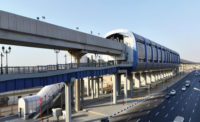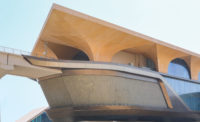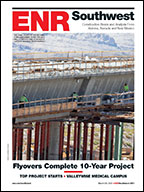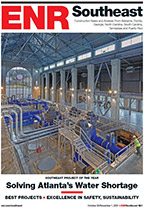After nearly 30 years, Lima Metro Line 1 is finally complete. Work on Line 1 began in 1986 but was abandoned during the economic crisis of the 1990s. The project remained on hold until 2009, when construction finally resumed. Phase two was awarded in 2011, allowing for the July 2014 completion of Lima's first metro line to connect the city's peripheral districts.
One judge noted that Line 1 was a "highly complex project in a very dense urban area with lots of sensitivities." The project crosses through heavily populated sectors, highways, the historic district of Lima and the Rimac River.
The project was completed in 36 months, three months ahead of the contractual deadline, for a total of $885.2 million. Several strategies, designs and technologies enabled the shortened completion time, including, during preconstruction, the relocation of water, electrical, gas and other utilities as well as 12.4 kilometers of overhead viaduct.
Precast construction helped speed construction to a completion three months ahead of schedule. The contractor used precast structural elements that could be produced simultaneously during construction. A 45,000-sq-meter precast plant produced more than 2,000 prestressed-concrete beams, 28,000 concrete slabs, 13,000 edges and 141 pier-cap beams for Line 1.
Work had to take place above the Rimac River and the Evitamiento Highway, one of the busiest thoroughfares in the city with approximately 37,000 vehicles a day. To accomplish this with minimal inconveniences to the public, the team built segmental bridges using a free-cantilever method—rather than building scaffolding over the river or closing the highway—allowing for aerial construction. Form travelers were equipped with lower-level platforms to prevent accidents caused by falling material.
Since Peru is located in the so-called Pacific Ring of Fire, a highly seismic area, Line 1's design follows the AASHTO Guide Specifications for LRFD Seismic Bridge Design 2009 standard, making it the first rail line in Peru to be developed under this standard.
Work also included 10 new passenger stations, a maintenance depot yard and the installation of electromechanical systems assembly.
Passenger stations for Line 1, as an overhead viaduct project, are above ground, so the urban surroundings had to be taken into account in coordination with Lima's municipalities.
Line 1 also integrated with some historic monuments, including the Lima City Wall and Presbitero Maestro Cemetery. To help enhance these areas, the project included a 700-m pedestrian walkway, with small squares and gardens; restoration of the portico of a historic building; construction of a site museum; and use of translucent materials for the roofs over both stations and the viaduct parapets between stations.
Teams clocked 15 million work-hours with no fatal accidents, 35 minor incidents and 14 lost-time incidents, which is a record in Peru, according to the teams. Further, this achievement was made with more than 4,000 workers in various civil and electromechanical roles working both day and night.
The project team consisted of companies and professionals from Peru, Brazil, Ecuador, Venezuela, Chile, Spain, Finland, Germany, Colombia, Argentina, Canada and the United States. To facilitate ongoing communications and coordination, the team used videoconferences, calls and email as well as a remote database that could be accessed from anywhere around the globe.
In one of Line 1's final steps, per the contractor's social and environmental obligations, workers restored areas affected during project construction, planting 5,900 trees, reseeding 217,700 sq m of grass and replacing 83,800 sq m of sidewalks and roadways. The 34.6-km Line 1 currently serves 450,000 people daily.
Project Team
Owner: AATE (Autoridad Autónoma del Tren Eléctrico)
Contractor: Consorcio Tren Eléctrico (Constructora Norberto Odebrecht and Graña y Montero)
Lead Design Firm: Constructor Norbeto Odebrecht
Civil and MEP Engineer: Odebrecht Infraestructura
Structural Engineer: T.Y. Lin International; Antonio Blanco Blasco Ingenieros EIRL
Public Work Supervisor: Consorcio CESEL-POYRY
Architectural Firm: De La Piedra Consultores SAC








